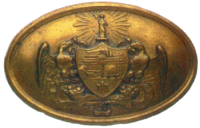 |
 |
 |
 |
|
We're speaking, of course, about the Arkansas State Militia belt plate that many of us purchase from the sutlers and wear in order to mark us as Arkansas troops. However, fewer than half a dozen of these belt plates exist today, and they were apparently rare even at the beginning of the War. Stanley C. Kerksis' book, Plates and Buckles of the American Military - 1794-1874 reports that at the time it was written in the 1960s there were only three known surviving examples of the Arkansas belt plates. 1st Lt. Omer R. Weaver, of the Totten Artillery Battery of Little Rock was apparently the first Arkansas soldier to be killed by enemy fire in the War, dying at the battle of Oak Hills, or Wilson's Creek, Missouri on August 10, 1861. When Weaver's body and personal effects were returned to his family later that month, an Arkansas belt plate was among his effects. This belt plate is now in the collection of the Arkansas History Commission. A second, and the most widely known, plate is in the collection of the Museum of the Confederacy in Richmond, Virginia. This plate belonged to Captain Christopher C. Scott, commander of the Arkansas Appeal Artillery battery. Scott originally enlisted in Fagan's 1st Arkansas Infantry, which served for approximately 9 months near Fredericksburg and Aquia Creek, Virginia before being transferred to Tennessee. After the battle of Shiloh, Scott transferred to the newly formed Appeal Battery at Memphis, TN, and was elected as an officer. The provenance of the Arkansas plates being issued to at least a few companies of Fagan's 1st Arkansas is further supported by the third belt plate, which is a fragmentary, dug relic from Confederate campsite near Fredericksburg, Virginia. A fourth Arkansas plate was found attached to a sword belt in an attic approximately 20 years ago. The belt was marked as belonging to "Captain Tucker", who was possibly Barnard H. Tucker of Co. E, 3rd Arkansas Infantry. This buckle remains in private hands. One Arkansas plate is commonly exhibited at local collector shows, however this specimen is a solid pewter casting, not brass; it has no belt hooks on the back, however has a small hole drilled in each end as if for a cartridge box plate, and has "3rd Ark. Dismounted Rifles" etched on its upper back side. This item is in all likelihood a reproduction casting. The original Arkansas buckles were made of a thin brass stamping, to which hooks were attached for fixing the plate to a belt, and the brass stamping was then filled with lead. The belt hooks, or studs are of the "puppy foot" variety, (see photo below) a type of stud which was used until about 1862 when the prong or arrow style of hooks came into common usage. Reproduction buckles that I have seen have all been made of solid cast brass, with pronged or arrow belt attachment studs. The absence of a lead-filled back is a guarantee that you're looking at a reproduction. The Confederate volume of Echoes of Glory attributes manufacture of the Arkansas plates to the Gaylord Company around 1860. At this time, no one really knows for sure who made them; whether they were made for the Mexican War militia or for the early volunteer militia units in Pulaski County. Probably less than a thousand to several hundred were made, and they were possibly a private purchase item. Units documented as having them all originated or were mustered in Little Rock in the early summer of 1861. As they were present with the Pulaski Light Artillery and Fagan's regiment, it is altogether likely that the members of the Capitol Guards may likely have worn these belts as well. All existing plates have come from the low-numbered regiments organized or raised from central Arkansas in May through July of 1861. But the initial number of Arkansas plates in the ranks would have steadily dwindled as the War progressed, and they would have gotten fewer and fewer as the War went on. There were apparently no replacement Arkansas plates made; once a soldier lost his old Arkansas belt or buckle, he would have received his replacement from the Confederate equipment depot, or from foraging on the field. So it it authentic to be wearing one of these plates while
depicting an Arkansas Confederate? It depends on the time you're
portraying. Early-war, single-digit infantry regiments very
possibly had access to these buckles and wore them; they simply
would not have been available after the Fall of '61 for the next
wave of regiments that fought mostly in the Trans-Mississippi. |